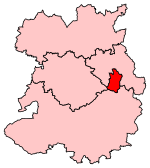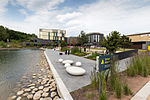Telford ( ) is a town in Shropshire, England. It is the administrative centre of Telford and Wrekin borough, a unitary authority which covers the town, its suburbs and surrounding settlements. The town is close to the county's eastern boundary, and near the River Severn.
The notable hill near the town called The Wrekin is part of the Shropshire Hills an Area of Outstanding Natural Beauty. To the south of the town, is the Ironbridge Gorge, a UNESCO World Heritage Site. Places around the Ironbridge Gorge area, which were developed into the town itself, are internationally recognised as being "The Birthplace of Industry" being to a large extent constructed during the Industrial Revolution on the Shropshire Coalfield.
The M54 motorway was completed in 1983, improving the town's road links with the West Midlands conurbation, Wolverhampton is 19 miles (31 km) south east and Birmingham is 28 miles (45 km) in the same direction. In the 2011 census, the town had a population of 142,723 while in 2017, the wider borough had an estimated population of 175,271. It is the most populous settlement in Shropshire, Shrewsbury is second and is 15 miles (24 km) to the west of the town. It is near Staffordshire: Stafford is 21 miles (34 km) to the east and Stoke-on-Trent is 25 miles (40 km) north east from the town.
The town is polycentric, having been designated under the New Towns Acts in 1963 and 1968 and developed between the 1960s to the 1970s. Centred on a shopping centre and a public park, the new town is named after Thomas Telford; a civil engineer to many road, canal and rail projects in the county. It was originally designated under the name Dawley New Town, Dawley being to the south of new-town’s centre. As well as multiple villages and Dawley, the other constituent towns are Wellington, Madeley and Oakengates.








